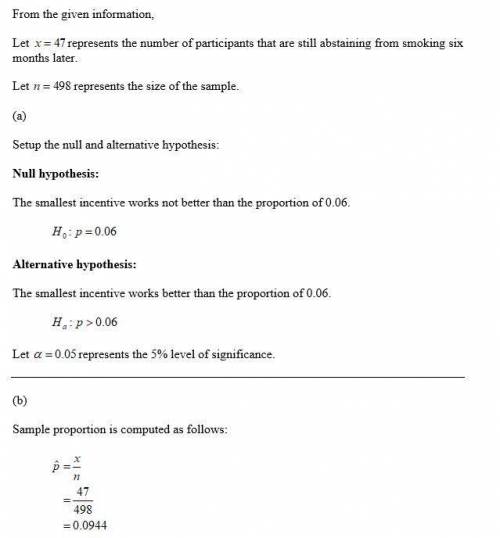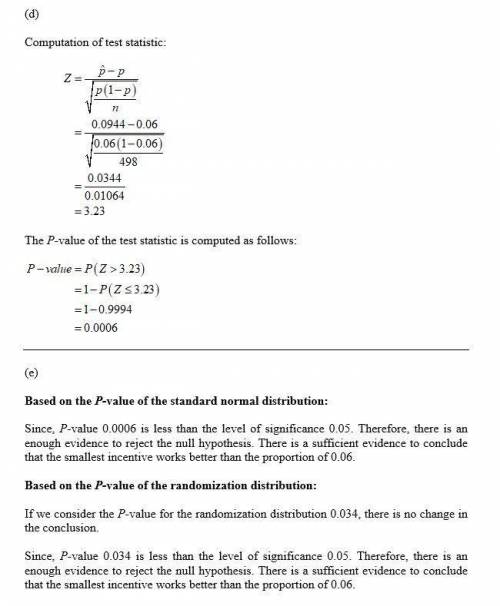
Mathematics, 21.02.2020 20:49, Andrewecolt1993
Incentives for Quitting Smoking: Do They Work? Exercise 5.31 describes a study examining incentives to quit smoking. With no incentives, the proportion of smokers trying to quit who are still abstaining six months later is about 0.06. Participants in the study were randomly assigned to one of four different incentives, and the proportion successful was measured six months later. Of the 498 participants in the group with the least success, 47 were still abstaining from smoking six months later. We wish to test to see if this provides evidence that even the smallest incentive works better than the proportion of 0.06 with no incentive at all. State the null and alternative hypotheses, and give the notation and value of the sample statistic. Use a randomization distribution and the observed sample statistic to find the p-value. Give the mean and standard error of the normal distribution that most closely matches the randomization distribution, and then use this normal distribution with the observed sample statistic to find the p-value. Use the standard error found from the randomization distribution in part (b) to find the standardized test statistic, and then use that test statistic to find the p-value using a standard normal distribution. Compare the p-values from parts (b), (c), and (d). Use any of these p-values to give the conclusion of the test.

Answers: 2
Other questions on the subject: Mathematics


Mathematics, 21.06.2019 21:30, Kittylover65
The price of a visit to the dentist is calculated according to the formula 50+100n50+100n where nn is the number of cavities the dentist finds. on your last visit to the dentist, 22 cavities were found. what was the cost of your visit?
Answers: 2

Mathematics, 21.06.2019 23:30, shady1095
Asap (i need to finish this quick) graph complete the sequence of transformations that produces △x'y'z' from △xyz. a clockwise rotation ° about the origin followed by a translation units to the right and 6 units down produces δx'y'z' from δxyz.
Answers: 1

Mathematics, 22.06.2019 00:30, brianlykid3042
Graph a point. start at your origin, move left 10 units, and then move up three units which ordered pair is the point you graphed
Answers: 2
Do you know the correct answer?
Incentives for Quitting Smoking: Do They Work? Exercise 5.31 describes a study examining incentives...
Questions in other subjects:

Mathematics, 04.02.2021 14:00


Mathematics, 04.02.2021 14:00

Mathematics, 04.02.2021 14:00

Physics, 04.02.2021 14:00




Physics, 04.02.2021 14:00

Mathematics, 04.02.2021 14:00









